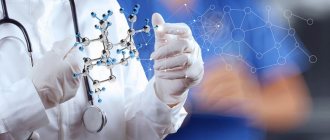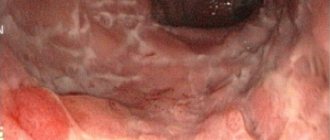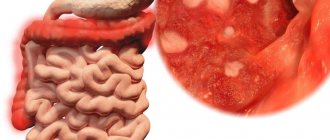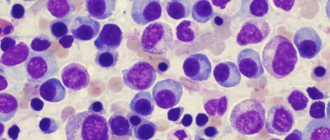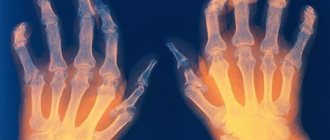What is the cause of excess sugar in the blood?
The pathogenesis of hyperglycemia is the insufficient production of insulin by pancreatic cells.
Without insulin, glucose entering the body with food is not absorbed by cells.
Metabolic disorders can occur not only from a lack of insulin, but also from impaired cellular sensitivity to insulin.
This results in a state of energy starvation of the cells, which is accompanied by an excess of glucose in the blood.
In this case, the body’s response to cellular hunger may develop: the liver will begin to process glycogen into glucose and release it into the blood, which in fact does not solve the problem, but only aggravates it.
Possible complications
With chronic manifestations of hyperglycemia over a long period of time, pathological processes in various organs and systems can develop in the body:
- kidney dysfunction, which leads to the development of renal failure;
- cardiovascular diseases, which increase the risk of heart attacks and strokes;
- diabetic neuropathy;
- retinal damage and cataracts;
- leg problems due to poor circulation;
- frequent bacterial and fungal skin infections.
Main symptoms of hyperglycemia
In medicine, there are three main signs of clinical hyperglycemia:
- frequent urge to urinate,
- thirst even after drinking enough water,
- weight loss for no apparent reason.
In addition to the main signs of the disease, several more can be identified:
- slow healing of cuts on the skin,
- dry skin, itching,
- fatigue for no reason,
- gradually developing farsightedness or myopia, a feeling of a veil before the eyes,
- untreatable candidiasis or chronic inflammation of the ear,
- deep noisy breaths, arrhythmia.
An important symptom of the disease and its complication is ketonuria, during which acetone is detected in the urine, or ketoacidosis, leading to a diabetic crisis and coma.
The mechanism of these complications is as follows:
- Since glucose does not enter the cells, its amount in the blood increases.
- The liver begins to break down glycogen into glucose in order to feed the cells with it, but it also does not enter the cells of the body’s tissues.
- At the same time, cells begin to break down fats to produce energy, which during their breakdown produce ketone bodies, that is, acetone.
- Acetone passes through the kidneys in large quantities and disrupts their function.
A state of renal failure occurs, in severe forms of which hemodialysis may be necessary.
Classification and symptoms of hyperglycemia
A person with high blood sugar may experience the following short-term symptoms:
- excessive thirst
- dry mouth
- excessive urination
- frequent urination at night
- blurred vision
- non-healing wounds
- fatigue
- weight loss
- recurrent infections such as thrush
If you are experiencing symptoms of hyperglycemia, it is important to check your blood glucose levels. Persistently high blood sugar can lead to chronic complications such as eye disease, kidney disease, heart disease, or nerve damage.
The symptoms listed above may develop over several days or weeks. The longer this condition remains untreated, the more serious the problem can become. In general, blood glucose levels greater than 10 mmol/L (180 mg/dL) after a meal, or greater than 7.2 mmol/L (130 mg/dL) before a meal, are considered high. Be sure to consult your doctor to know your blood sugar levels.
Good control of diabetes and careful monitoring of blood glucose levels are very effective ways to prevent hyperglycemia.
- Check your blood glucose levels regularly. Check and record your blood glucose levels daily. Provide this information to your doctor at every visit.
- Control your carbohydrate intake. Know how many carbohydrates you consume at each meal and snack. Try to stick to the portion sizes recommended by your doctor or dietitian.
- Have a plan of action. When your blood glucose reaches certain levels, take the medicine as prescribed, based on the amount of food you eat and the timing of your meals.
- Wear a medical identification bracelet. If a major problem arises, medical bracelets or necklaces can help alert health care providers about your diabetes.
To prevent the development of serious complications, it is necessary not only to know the symptoms of the disease, but also to identify them in a timely manner. Experts distinguish between early and late signs of hyperglycemia. The early ones include:
- increased thirst;
- dry mouth;
- frequent headaches;
- blurred vision;
- increased fatigue;
- frequent urination;
- weight loss;
- itching of the skin.
Hyperglycemia manifests itself in the form of drowsiness, nausea, extreme thirst, and hunger.
Hyperglycemia that lasts for a long time often leads to more severe disorders:
- skin and vaginal infections;
- worsening healing of wounds and cuts;
- nerve damage;
- impaired sensitivity in the limbs;
- problems with the gastrointestinal tract - diarrhea and constipation.
Persistent hyperglycemia can provoke the development of ketonuria (the appearance of acetone bodies in the urine), as well as ketoacidosis (a disorder of carbohydrate metabolism). The latter often leads to diabetic coma.
During pregnancy, some women are diagnosed with gestational diabetes, one of the symptoms of which is hyperglycemia. Its occurrence is due to a decrease in insulin production, which leads to an increase in blood sugar concentrations. As a rule, it is temporary and disappears without a trace after the birth of the child.
Babies, especially newborns, can also develop hyperglycemia. At an early age, this may be due to low body weight (less than 1.5 kg) or provoked by diseases such as sepsis, meningitis, encephalitis, etc. In older children, poor nutrition and a sedentary lifestyle contribute to its occurrence. Early detection of the disease helps to avoid the development of severe complications, in particular cerebral edema, hemorrhage, and diseases of the endocrine system.
To exclude the occurrence of hyperglycemia, it is necessary:
- lead a healthy and as active lifestyle as possible;
- exercise regularly;
- stick to a healthy diet.
If there is a slight increase in blood sugar levels, you should adjust your diet and conduct a routine examination in a timely manner in order to treat possible diseases.
Hyperglycemia is a dangerous condition that is fraught with the development of severe complications, in particular diabetes mellitus. Therefore, if specific symptoms occur, you should seek medical help as soon as possible.
Due to the fact that the consequences of hyperglycemia are unfriendly, it is important to take measures to lower blood sugar levels at the first characteristic signs of its manifestation.
Important and characteristic symptoms are sudden thirst, increased appetite and indefatigable hunger, frequent urination, decreased vision - blurred vision and spots before the eyes.
Patients with elevated sugar levels experience a constant feeling of fatigue, headache, confusion and irritability.
Pronounced symptoms include excessive sweating, chills, numb lips and dry skin.
High sugar levels are characterized by the smell of acetone from the mouth.
Very rarely, hyperglycemia is asymptomatic.
Depending on the level of glucose in the blood, there are several degrees of severity of the disease:
- mild – 6.7-8.2 mmol/l;
- average – 8.3-11 mmol/l;
- severe – blood sugar level exceeds 11.1 mmol/l.
If the glucose concentration increases to more than 16.5 mmol/l, a precomatous state develops; when the glucose level increases to 55 mmol/l, the patient is diagnosed with hyperosmolar coma. It is a serious condition for the body and in most cases ends in the death of the patient.
It is very important to be able to provide first aid to a person with hyperglycemia in a timely manner. In most cases, such actions help save the patient's life.
- Insulin-dependent diabetics during an attack of acute hyperglycemia need to administer insulin by injection. It is recommended to check and try to lower your blood sugar levels first. It is necessary to inject the hormone every 2 hours, regularly checking the glucose level until it returns to normal. In rare cases, it may be necessary to lavage the stomach with a warm solution containing a small concentration of soda.
- If first aid does not have positive results, you must take the patient to a medical facility yourself or call an ambulance. If this is not done in time, then an excessive amount of sugar in the blood will lead to acidosis and disruption of the respiratory system. In the hospital, with such a course of hyperglycemia, an infusion drip is most often prescribed.
Hyperglycemia, the symptoms of which are mild, can be eliminated with available means. To reduce acidity in the body, you can drink still water, herbal infusions, soda solution, or eat fruit. If dry skin occurs, rub the body with a damp towel.
There are several degrees of severity of symptoms:
- mild degree – characterized by a slight increase in sugar, does not exceed 10 mmol/l;
- moderate degree – glucose concentration does not rise above 16 mmol/l;
- severe hyperglycemia - blood sugar levels above 16 mmol/l can lead to coma.
There are two types of syndrome:
- Hyperglycemia on an empty stomach - when blood sugar on an empty stomach exceeds 7.2 mmol/l.
- Postprandial - within 8 hours after eating, the glucose level exceeds 10 mmol/l.
Depending on the causes of occurrence, types of hyperglycemia are classified as hormonal, chronic, emotional and nutritional.
The cause of chronic hyperglycemia is pancreatic dysfunction. As a result of cell destruction, the affected organ cannot produce enough insulin. This leads to a persistent excess of glucose in the blood and is observed in type 1 diabetes.
It happens that cells stop recognizing insulin and become immune to its action, which is also accompanied by an increase in sugar concentration. This is typical for type 2 diabetes.
Functional disruptions of the endocrine system can occur under the influence of hereditary and acquired diseases.
An overdose of insulin during the treatment of diabetes mellitus can cause post-hypoglycemic hyperglycemia. The body's response to a rapid drop in sugar levels will be increased production of glucose.
A physiological reaction to prolonged stress and psychological tension is the manifestation of emotional hyperglycemia. An increase in sugar concentration occurs as a result of the release of hormones that stop glycogenesis and accelerate glycogenolysis and gluconeogenesis.
Nutritional hyperglycemia occurs after heavy consumption of foods high in carbohydrates. This condition will soon normalize naturally.
An increase in glucose levels in the body can be triggered by hormonal changes due to kidney diseases, pancreas diseases and cancer.
Mild hyperglycemia often goes undetected. Loss of strength and frequent desire to drink water are usually ignored.
Significant signs appear as the pathology progresses:
- frequent and copious urination;
- dry mouth and increased water consumption;
- itching and low rate of tissue regeneration;
- drowsiness, feeling of weakness;
- susceptibility to fungal infections.
In severe cases, the following symptoms are observed:
- frequent constipation or diarrhea;
- attacks of nausea, migraine, weakness;
- blurred vision, spots before the eyes;
- smell of acetone and rot;
- drop in blood pressure, blue lips, fainting.
There may be a decrease in tactile sensitivity and a feeling of coldness in the extremities. Significant weight loss is possible while maintaining your usual lifestyle and diet.
With increasing symptoms, accompanied by convulsions and confusion, coma may develop.
If you notice signs of high blood sugar, you need to check your blood glucose levels. If the deviation from the norm is insignificant, then you should visit a doctor and get advice. Glucose levels exceeding 13 mmol/l require immediate medical attention.
When providing assistance to a patient with an attack of hyperglycemia, it is necessary to remember that the symptoms of high glucose levels and hypoglycemia are similar, and incorrect actions can only aggravate the situation.
The following should be done:
- first of all, you need to call a medical team;
- lay the patient down and provide air access;
- give plenty of fluids;
- exclude food intake and sugar;
- prepare the documents and things necessary for hospitalization.
Folk remedies
What can high blood sugar lead to?
The pathogenetic significance of hyperglycemia lies in the unnoticed occurrence of severe complications.
Such conditions are invisible for a long time, but their long-term impact on the human body is even more terrible.
Doctors identify the most severe complications:
- Diseases of the cardiovascular system, which can provoke the risk of heart attack and stroke.
- Excessive stress on the kidneys can lead to kidney failure.
- The risk of complications on the nervous system, which is manifested by constant tingling and various pain sensations in the limbs.
- Serious damage to the retina, including glaucoma and cataracts.
- Periodontal disease.
One of the most important factors influencing the occurrence of complications in a state of hyperglycemia is the leaching of a large number of useful substances, such as sodium salts, chlorides, which take an active part in metabolism, along with the urine during ketocidosis.
The leaching of potassium salts leads to the appearance of diseases of the cardiovascular and nervous systems, and sodium salts maintain the necessary pH balance of the blood.
Symptoms
When there is excess glucose in the blood, it also appears in the urine (normally it should not be there). The main symptom of hyperglycemia is extreme thirst. A person is always thirsty. Sometimes the amount drunk per day can reach up to 6 liters. In turn, excess fluid is reflected by increased urination.
READ ALSO: Effective methods of treating diabetes mellitus with folk remedies at home: recipes and features of the use of herbal remedies
Together with urine, beneficial salt ions are removed from the body, which causes:
- constant weakness;
- headache;
- sudden weight loss;
- dry, itchy skin;
- decreased vision.
With a critical concentration of sugar in the bloodstream, a hyperglycemic coma can occur. This condition requires emergency hospital care. The accumulation of large amounts of ketone bodies in the body causes ketoacidosis. Dehydration occurs, breathing is impaired, central nervous system functions are inhibited, appetite disappears, and pain appears in the abdominal cavity.
The transition from mild to severe hyperglycemia can take years. But this is possible when the thyroid gland itself is still able to synthesize insulin (with type 2 diabetes).
Forms of hyperglycemia
The process of increasing blood glucose can be determined not only by specific signs, but also by the results of blood biochemistry. A sugar test can show the level of disease development:
- a mild degree of the disease is characterized by a glucose concentration in the patient’s blood from 6.5 to 8.3 mmol/l,
- average degree, from 8.4 to 11.1 mmol/l,
- severe degree is considered an increase in blood sugar of more than 11.1 mmol/l.
Dangerous for humans is an increase in sugar above 16.6 mmol/l, which is a harbinger of coma. And when the glucose concentration is above 55.6 mmol/l, a state of hypersmolar coma may occur.
Important! The normal excess level of glucose in the blood is considered to be 7.7 mmol/l after eating.
If after eating the upper level reaches 10 mmol/l, then in this case there is a risk of developing type 2 diabetes mellitus.
In children, the normal level of sugar on an empty stomach is considered to increase to 6.4 mmol/l, and after eating the maximum possible amount of glucose is no more than 8.9 mmol/l.
You can measure your glucose level not only in the hospital, but also at home.
Hyperglycemia syndrome: symptoms and manifestations of the disease
A number of risk factors may contribute to the development of hyperglycemia, including:
- Eating more carbohydrates than usual.
- Decreased physical activity.
- Disease or infection.
- High stress levels.
- Incorrect dosage of drugs that lower blood glucose levels.
- Insulin resistance in type 2 diabetes mellitus.
Among the factors that cause changes in blood glucose levels are endocrine diseases and general disorders in the body. Endocrine factors include:
- Diabetes mellitus is a pathology associated with a complete or partial lack of the hormone insulin in the body. Symptoms of hyperglycemia in diabetes include being overweight or obese.
- Thyrotoxicosis occurs when the thyroid gland overproduces thyroid hormones.
- Acromegaly is a pathology characterized by an increase in the level of growth hormone.
- Pheochromocyte is a tumor localized in the adrenal medulla. Provokes excessive production of adrenaline and norepinephrine.
- Glucagonoma is a malignant tumor that secretes glucagon. Symptoms are similar to diabetes mellitus and are manifested by changes in body weight, anemia and dermatitis.
Symptoms of hyperglycemia in children appear when leading an unhealthy lifestyle, regular consumption of sweet and unhealthy foods, carbonated drinks and lack of physical activity. Factors of general disturbances in the functioning of the body can be:
- binge eating;
- indigestion;
- severe stress;
- consequences of heart attack and stroke;
- infectious and chronic diseases;
- side effects of certain medications.
Within 1-2 hours after eating, the sugar level in a healthy person increases by 1-3 mmol/l. Then the indicator gradually decreases and returns to normal 5 mmol/l; if this does not happen, we can conclude that hyperglycemia has developed. This condition requires medical intervention and effective treatment.
The first signs of hyperglycemia appear in the form of increased fatigue and decreased performance. Clinically, at this stage, one can detect a slight increase in blood sugar levels after meals and long-term persistence of levels above normal. The following symptoms are also characteristic of hyperglycemia:
- disturbances in concentration;
- excessive thirst;
- frequent urination;
- dizziness and headaches;
- pale skin;
- apathy;
- drowsiness;
- nausea;
- heart rhythm disturbance;
- decreased blood pressure;
- decreased visual acuity;
- sweating;
- itching of the skin;
- ketoacidosis (pH imbalance that leads to coma).
The progression of the pathology causes increased symptoms and serious disruptions in the functioning of body systems.
The main preventative measure for hyperglycemia is nutrition control and daily activity. It is very important to create a rational menu and stick to it so that the body receives all the microelements, vitamins and fibers it needs for proper functioning and ensuring all vital processes.
A healthy lifestyle and good heredity will prevent diabetes. Hyperglycemia, the symptoms of which are fatigue and drowsiness, is easier to treat. Whereas if there are disturbances in the course of internal metabolic processes, therapy will be long-term, and the diet will have to be followed constantly.
The main cause of hyperglycemia, which leads to an increase in the concentration of glucose in the blood serum, is a decrease in the body's production of insulin. In some cases, the patient's insulin level is within the normal range, but at the same time it interacts incorrectly with the cells of the human body, which also leads to an increase in glucose levels.
The development of hyperglycemia can also be promoted by a diet with a high amount of carbohydrates and overeating.
Stress can also be a cause of hyperglycemia. Therefore, it is so necessary to control your emotional, psychological, and physical stress, avoiding either an overly passive lifestyle or severe overwork.
The causes of hyperglycemia can be various infectious and chronic diseases.
In patients with diabetes mellitus, an attack of hyperglycemia occurs when they miss a dose of medications that lower sugar levels or an insulin injection.
The main reason for the development of the symptom is the reduced production of the hormone insulin, which lowers the concentration of sugar in the blood.
The mechanism for the development of hyperglycemia is the insufficient production by the pancreas of one of the most important hormones that affects carbohydrate metabolism and regulates the level of glucose in the blood.
The pancreas is part of the human endocrine system and replenishes the energy consumption of the required amount of glucose to all tissues and organs. But to transport and control glucose levels, the hormone insulin is necessary, without which the sugar content is not regulated and, as a result, cell starvation occurs and its excess in the blood. Therefore, they often talk about a conflict at the cellular level in the mechanism of development of hyperglycemia.
There are long-term and temporary hyperglycemia.
Temporary hyperglycemia can occur when eating high-calorie foods with a high carbohydrate content.
A temporary increase in blood sugar can be caused by the release of adrenaline and thyroxine into the blood as a result of pain.
Hyperglycemia often occurs against the background of stressful situations, pregnancy, adrenal hyperplasia, low levels of vitamins B1 and C in the body, carbon oxide poisoning, and bleeding. Quite often, hyperglycemia is provoked by certain medications - fentamidine, β-blockers, corticosteroids, antidepressants and a number of other medications.
Long-term hyperglycemia develops when the regulation of carbohydrate metabolism of a neuroendocrine nature is disturbed.
A hyperglycemic state develops under the influence of the following factors:
- tendency to overeat;
- unbalanced diet with a predominance of foods high in carbohydrates;
- prolonged stress and anxiety;
- lack of vitamin B1 and C;
- pregnancy period;
- injuries accompanied by significant blood loss;
- the entry of adrenaline into the blood as a result of intense pain;
- adrenal dysfunction;
- chronic or infectious diseases;
- low or excessive physical activity.
Chronic diseases of the endocrine system also contribute to increased blood sugar. Diabetes causes pathological changes in the cells of the pancreas, resulting in a reduction in the amount of insulin produced.
Type 2 diabetes causes cells to lose sensitivity to insulin and the hormone cannot neutralize excess glucose.
A dangerous symptom can also occur with diseases such as:
- Cushing's syndrome;
- severe liver and kidney diseases;
- inflammatory processes in the pancreas;
- malignant neoplasms in the pancreas;
- thyrotoxicosis;
- stroke;
- injuries and operations.
A patient admitted with an acute attack of hyperglycemia is given an insulin injection. After normalizing the glucose level, intravenous infusion restores the water balance and the missing vitamins and microelements. Before the examination, a diagnosis of unspecified hyperglycemia is made - ICD code 10 R 73.9.
If the cause of the increase in blood sugar is diabetes mellitus, then the patient will be observed by an endocrinologist and monitor the glucose concentration using a glucometer throughout his life. Treatment consists of following the doctor's recommendations, regularly taking prescribed medications, following a strict diet and lifestyle changes.
Patients with type 1 diabetes are prescribed insulin therapy. The injection dose is carefully calculated by the doctor.
For type 2 diabetics, medications are recommended that increase insulin production or restore cell sensitivity to the hormone.
Drug therapy may include the following drugs:
- Actos - restores cell sensitivity to insulin;
- Bayeta – normalizes appetite;
- Glucophage, Siofor - drugs for the treatment of diabetes.
To reduce the increased acidity in the stomach that occurs after hyperglycemia syndrome, you can drink a solution of baking soda or regularly drink alkaline mineral water.
If diabetes mellitus is not diagnosed and hyperglycemia manifests itself as a result of another disease, then it is necessary to establish the disease and undergo a course of treatment.
After the cause disappears, the sugar will remain normal.
A mandatory goal for everyone will be to limit the amount of carbohydrates consumed, eliminate sugar from the diet and exercise in moderation.
Uncontrolled diabetes and frequent fluctuations in blood glucose levels can lead to serious heart disease, kidney disease, vision problems and negatively affect the nervous system.
Diet
Adjusting your diet will help keep your glucose levels within acceptable limits. The diet should be agreed with the endocrinologist. It is the doctor who will recommend a suitable diet.
The basic principles of proper nutrition when prone to hyperglycemia are:
- Limit foods high in fast carbohydrates to a minimum.
- Nutrition should be balanced. Approximately 30% protein, 30% vegetable fats and 40% complex carbohydrates.
- The basis of the diet is porridge and side dishes from cereals. Lentils are very healthy, but it’s better not to indulge in rice dishes.
- Meat and fish dishes with low fat content are recommended to be boiled, baked and stewed. Preference is given to rabbit meat, turkey, and skinless chicken breasts.
- Fresh greens and vegetables will provide essential vitamins and fiber. Limit your potato consumption only. Choose unsweetened fruits and do not overuse citrus fruits.
- Choose dairy products with a small percentage of fat content.
- Exclude sweets, pastries, and wheat bread. Replace bread with whole grain bread, and use stevia, honey, and sweeteners instead of sugar.
- You will have to give up fatty and fried foods, grapes, bananas and other sweet fruits. Fatty sauces, sausages and smoked products, semi-finished products and carbonated drinks should also not appear on the table.
- You need to eat often and in small portions. It is equally harmful to overeat and take long breaks between meals.
Folk remedies
Causes of hyperglycemia
Factors leading to the risk of developing hyperglycemia can be divided into several groups:
- insulin dependent,
- physiological,
- non-diabetic,
- hormonal.
The state of excess sugar in the blood can be caused not only by the development of diabetes, but also by the loss of the pancreas of its functions to provide the body with the required amount of hormones, as well as other reasons.
Diabetic causes
Chronic hyperglycemia develops in diabetes mellitus of the first and second types.
Since indicators of elevated blood glucose levels in diabetes are constant, hyperglycemia is called chronic.
The pathology develops due to insufficient production of insulin by the hormone-producing cells of the pancreas.
Therefore, glucose accumulates in the blood without entering the cells of the skeleton and other body systems. The symptoms are persistent and long-lasting.
Chronic hyperglycemia syndrome in diabetes mellitus
Chronic hyperglycemia syndrome is caused not only by insulin deficiency. It also includes some nephropathy and angiopathy.
The following diseases are manifestations of the symptom complex:
- malignant tumors of the pancreas,
- pancreatitis of varying severity,
- diseases caused by infectious agents,
- genetic disorders and various syndromes.
Hyperglycemia syndrome may also include various immune disorders, including allergies. With a chronic lack of insulin, cerebral atherosclerosis may occur due to impaired liver function.
Physiological hyperglycemia
Physiological hyperglycemia is divided into three types according to its manifestations:
- Postprandial hyperglycemia, during which a temporary increase in blood sugar occurs due to overeating and consuming a large number of calories at a time.
- Transient hyperglycemia is determined when blood is taken incorrectly during analysis.
The subject may violate the rules for testing serum for sugar by eating something before the test or becoming nervous.
In this case, the result will show an excessive excess of the fasting norm of sugar, which the patient actually does not have.
- Stress hyperglycemia or emotional hyperglycemia occurs after a strong experience or as a result of prolonged stress.
Glucose concentration peaks and then decreases.
This happens due to the release of stress hormones: cortisol and adrenaline, which affect the conversion of glycogen into glucose. Thus, the amount of sugar in the blood increases sharply.
- Acute hyperglycemia can be caused by excess physical activity, since muscle work can cause severe energy starvation of cells, which will trigger the release of glucose into the blood from glycogen stores in the liver.
Hyperglycemia of unspecified etiology often occurs, when the causes of increased blood sugar cannot be determined.
Attention! The patient should follow the rules for preparing for a sugar test. He gives up on an empty stomach, in the morning. Do not brush your teeth or eat anything before doing this. You are only allowed to drink clean, plain water.
Hormonal hyperglycemia
Hyperglycemia can be caused by taking certain hormonal drugs:
- beta cell blockers,
- antidepressants,
- corticosteroids.
In addition to taking artificial hormonal drugs, hyperglycemia is caused by the release of hormones from the endocrine glands:
- cortisol, adrenaline and norepinephrine, which are produced by the adrenal glands,
- liothyronine and thyroxine, produced by the thyroid gland,
- somatotropic hormone, which is produced in the pituitary gland.
Complex mechanisms for regulating metabolism in the body depend on a large complex of reasons, and are often associated with a whole chain of hormonal disorders in the body.
Causes
There are several culprit factors. Many arise spontaneously.
- A clinically significant increase is possible during a stressful situation. For example, after suffering a severe infectious-inflammatory process, heart attack or stroke. An increase in glucose concentration is an additional factor in the mortality of these conditions.
- The use of certain medications can provoke this effect. Among them are names for the treatment of cancer tumors, cytostatics and immunosuppressants. There are not many drugs that can do this. Doctors warn in advance about the possibility of an increase in blood sugar levels. If necessary, reduce the dosage or change the drug to another.
- Nutritional problems. For example, with significant overeating, consumption of large amounts of starch, pure sugar, quickly digestible carbohydrates in one sitting. The body simply does not have time to produce such an amount of insulin. A similar condition is typical for patients with bulimia. Nervous overeating leads to a colossal amount of calories. Neutralization will take time. If you continue in the same spirit, there is a real opportunity to become a patient of an endocrinologist.
- Diabetes. A typical condition associated with an increase in glucose levels. Available in two versions. The first one depends on insulin. Little of it is produced. As a rule, this is a process independent of body weight. The second is caused by the insensitivity of cells to the named substance. Resistance is usually the result of obesity and hormonal imbalance. An important component of therapy is weight normalization.
There are not many reasons.
Non-diabetic factors
The mechanism for increasing blood sugar can be triggered by an inflammatory process or infection.
The following are non-diabetic causes of hyperglycemia:
- myocardial infarction or stroke,
- various pathologies of the genitourinary system that affect the loss of glucose in the urine,
- occurrence of a burn,
- adrenal insufficiency,
- pancreatic oncology, acute and chronic pancreatitis,
- metabolic failure in newborns,
- hyperthyroidism, acromegaly and other endocrine diseases,
- liver diseases, in which there is a decrease in glycogen production and gluconeogenesis, vitamin B1 deficiency, chronic hepatitis and cirrhosis of the liver,
- hereditary genetic abnormalities.
Exceeding the normal concentration of glucose in the blood that occurs after various injuries, strokes, and heart attacks is called reactive hyperglycemia, which, according to statistics, signals an increased risk of death in people who have experienced this attack.
Carefully! Acute hyperglycemia can be complicated by a sharp decrease in blood pressure, as well as an increase in ketone bodies in the blood serum. This disruption has long-term consequences even after carbohydrate metabolism is restored.
Hyperglycemia: treatment
Most treatments for hyperglycemia involve insulin injections to lower serum sugar levels, treatment of the underlying disease causing hyperglycemia, such as diabetes, and general detoxification of the body with infusions of carbohydrates, proteins and vitamins to balance the acid-base balance.
If hyperglycemia is diagnosed in a patient for more than three days in a row, an individual treatment regimen is drawn up, which includes not only medications and prescriptions, but also recommendations on rest and work patterns, nutrition and diet.
Diagnostics
Since hyperglycemia is a manifestation of various conditions or diseases, its diagnosis should be differential. This study is carried out in three stages:
- anamnesis collection,
- symptom analysis,
- laboratory research.
Final conclusions can only be drawn after receiving the results of a blood sugar test, which is performed on an empty stomach.
Repeat the analysis after eating, two hours later. It will also be useful to monitor the state of glucose over time, taking blood sugar readings throughout the day, every hour.
Fact! To exclude the influence of stress on the body, a repeat study is prescribed a week after the analysis.
If a concomitant disease is suspected, a biochemical blood test is prescribed, as well as other types of examinations to confirm the diagnosis.
Causes of temporary and long-term hyperglycemia
A hyperglycemic state can last a long time or be a short-term phenomenon.
The reasons for a temporary increase in plasma glucose are given below:
- frequent stress;
- excessive consumption of carbohydrate foods;
- pregnancy;
- severe pain, during which thyroxine and adrenaline increase in the blood;
- deficiency of vitamins C and B1;
- poisoning with carbohydrate oxides;
- heavy bleeding;
- steroid diabetes;
- hyperplasia of the adrenal cortex;
- taking certain groups of medications. For example, antidepressants, diuretics, beta blockers, fentamidine, niacin increase blood sugar;
- infectious diseases;
- unbalanced physical activity.
Long-term hyperglycemia is caused by impaired carbohydrate metabolism and disruptions in the functioning of endocrine organs.
The most common causes of hyperglycemia are listed below:
- In type 1 diabetes, insulin synthesis is greatly reduced due to the destruction of pancreatic cells and inflammatory processes in the organ. When 75% of the cells that produce the hormone are destroyed, hyperglycemia occurs;
- In the second form of diabetes, the sensitivity of insulin to the body's cells is impaired. The hormone is not absorbed even with sufficient production. Therefore, blood glucose increases.
Knowing the causes of hyperglycemia and avoiding the factors that provoke it, there is a chance to reduce the likelihood of high blood sugar.
Treatment of hyperglycemia syndrome
Read the ICD code for hyperglycemia
Since hyperglycemia syndrome has many causes, its treatment will be based on accurate diagnosis and elimination of not only the effect, but also the causative factors.
First of all, doctors pay great attention to eliminating infections and inflammatory processes, and also prescribe a special diet with reduced carbohydrate intake.
For people suffering from diabetes, insulin replacement therapy is immediately prescribed.
For chronic increases in blood sugar, oral prandial regulators, repaglinide and nateglinide have proven beneficial.
Active substances that are derivatives of amino acids are involved in restoring the insulin response to food intake.
The flexibility of taking the drug, which is directly related to the amount of food consumed, does not interfere with the quality of life of people with hyperglycemia.
Long-term hyperglycemia should be constantly monitored not only by an endocrinologist, but also by other specialists:
- cardiologist,
- neurologist,
- ophthalmologist,
- urologist.
Thus, the possibility of complications occurring in other organs remains under the control of specialists. To do this, it is recommended to undergo a medical examination once every six months, or as needed.
Etiology[ | ]
Diabetes mellitus[ | ]
Main article: Diabetes mellitus
Chronic hyperglycemia, which persists regardless of the patient's condition, most often occurs in the case of diabetes mellitus and is in fact the main characteristic of this disease.
An acute episode of hyperglycemia for no apparent reason may indicate the manifestation of diabetes mellitus or a predisposition to it. This form of hyperglycemia is caused by insufficient insulin levels. Insulin catalyzes the transport of glucose across cell membranes, thereby lowering the level of free sugar in the blood.
Eating disorders[ | ]
Eating disorders can lead to acute non-diabetic hyperglycemia, for example, with bulimia nervosa, when a person does not control the amount of food eaten and, accordingly, receives a huge amount of calories per meal. Thus, a large amount of simple and complex carbohydrates comes from food.
Certain medications may increase the risk of hyperglycemia: β-blockers, thiazide diuretics, corticosteroids, niacin, phentamidine, protease inhibitors, L-asparaginase, and some antidepressants.
Biotin deficiency also increases the risk of developing hyperglycemia.
Stress[ | ]
In most patients who have suffered acute stress (stroke or myocardial infarction), hyperglycemia can develop even beyond the diagnosis of diabetes mellitus. Observations of patients and animal studies have shown that such post-stress hyperglycemia is associated with higher mortality in stroke and heart attack.
Hyperglycemia can develop against the background of infection and inflammation or stress. This process is triggered by endogenous counter-insulin hormones (catecholamines, glucocorticoids and others). Therefore, an increase in blood glucose levels should not immediately be regarded as type 2 diabetes mellitus - first, all other causes should be excluded (including diabetes mellitus in children, which often manifests itself in such situations).
Side effect[ | ]
It is a common side effect from the use of the anticancer drug MabThera (Rituximab).
First aid
In the event of acute hyperglycemia or a hyperglycemic crisis, the victim may require prompt first aid:
- First, if possible, you need to measure your blood sugar level with a glucometer, which will not take much time. If suspicions of a sharp jump in glucose are confirmed, you should take the following measures:
- Call an ambulance, as only professional medical intervention can help prevent serious consequences.
- Give plenty of fluids to the victim to remove harmful substances from the body. In the first half hour, this should be at least 1 liter of clean water, and then give half a liter of water every hour.
- If the patient has lost consciousness, he should be placed on his side so that he does not suffocate on his own tongue.
If a person knows that he has diabetes and takes the necessary medications, in particular insulin, then he should be given an injection, but only if the glucose level exceeds 15 mmol/l, since untimely use of an insulin drug can cause a sharp drop in sugar, which is also dangerous for a person .
Treatment
Mild hyperglycemia does not need to be treated with medication. Glucose levels are normalized by changing lifestyle and diet.
It is also useful to regularly perform physical exercises that are appropriate to the person’s condition and age. If diabetes is diagnosed, insulin injections will be required.
Drug Siofor
Today, endocrinologists actively use the following drugs to treat hyperglycemia:
- Victoza . Controls appetite and reduces the likelihood of overeating;
- Siofor . Reduces plasma glucose concentration;
- Glucophage . Acts similarly to Siofor;
- Aktos . Increases the sensitivity of human body cells to insulin.
The endocrinologist selects the treatment regimen and dose individually for each patient. During therapy, it is important to monitor your diet. In people with diabetes who use antihyperglycemic agents, hypoglycemia may occur if food is not taken on time.
If the cause of hyperglycemia is acute pancreatitis or another disease, the underlying pathology must be treated.
There are many traditional medicine methods on the Internet that can help overcome hyperglycemia. Essential oils contained in certain plants help reduce blood sugar levels and stabilize the patient's condition.
These properties are especially pronounced in juniper, eucalyptus and geranium. Tea made from birch leaves, blueberries, a decoction of burdock rhizomes, and bean leaves are beneficial.
Any traditional recipes must be agreed with your doctor. Otherwise, there is a risk of worsening the condition.
Diet for hyperglycemia
When hyperglycemia is diagnosed, the patient is prescribed a special diet, which he must constantly adhere to.
At the same time, eating foods containing simple and complex carbohydrates is not allowed. These are, first of all, the following products:
- sweets, cakes,
- bakery,
- pasta,
- sweet fruits,
- potato,
- rice.
Hyperglycemia affects certain eating behavior of a person suffering from this disease.
By following these rules, you can maintain your blood sugar balance:
- reduce the time between meals, eat often and in small portions,
- reduce the consumption of fried foods and spicy foods,
- include plenty of fresh vegetables and unsweetened fruits in your diet,
- eat plenty of protein, white meat, eggs,
- include fermented milk products in your diet,
- For sweets, you can only eat dried fruits or special sweets,
- drink more water.
These simple rules will make you feel much better and reduce the likelihood of complications.
Treatment with folk remedies
An alternative method of maintaining blood glucose levels is herbal medicine. Plants are selected from a number of alkaloids:
- dandelion,
- elecampane,
- goat's rue leaves.
Alkaloids have the ability, like insulin, to help glucose pass through cell membranes, thereby normalizing metabolism.
An excellent recipe for treating with beans: take fifty young bean pods per two liters of boiling water. Cook the beans for about three hours in a steam bath. Strain the broth and drink this remedy 4 times a day before meals, half a glass. The course of admission is at least one annual quarter.
One of the effective folk methods is the use of Jerusalem artichoke as a medicine. To do this, you need to boil it for a quarter of an hour and take the cooled broth half an hour before meals.
Decoctions and infusions from the following plants are no less effective:
- blueberry leaves,
- lilac inflorescences,
- Bay leaf,
- horseradish leaves and roots,
- steamed oats,
- red ginseng.
In addition to their insulin-replacement function, they also have the ability to strengthen the immune system and help the liver cope with the processing of harmful substances.
Blueberry leaves additionally have a diuretic effect and prevent complications on the kidneys.
Bay leaf is good for preventing the leaching of nutrients from the body, and it also serves as an excellent prevention of gout.
Effective Treatment Options
Therapeutic interventions include several methods. The main condition of therapy is constant monitoring of the amount of sugar in the blood. Therefore, you should always have a glucometer at hand. It is better to start treatment with non-drug methods.
READ ALSO: How and how to reduce sugar quickly at home without drugs: nutrition correction, physical activity, traditional medicine remedies and recipes
First aid
In case of hyperglycemia, before contacting a specialist, the patient can take the following measures:
- drink plenty of alkaline water with calcium and sodium;
- drink a glass of water with a spoonful of soda dissolved in it;
- eat a lot of vegetables;
- Apply a damp towel to the wrists, neck, and face.
A patient with type 1 diabetes should measure blood glucose, if it is more than 14 mmol/l, administer the required dose of insulin. In this case, you need to ensure plenty of fluids.
Diet and nutritional habits
Glucose levels are greatly influenced by a person's diet. For mild hyperglycemia, a therapeutic diet is the main method of therapy and control of sugar levels. Patients need to stop eating simple carbohydrates and limit complex carbohydrates. Take food 5-6 times a day, portions should be small (no more than 300 g).
The basis of the menu should be proteins:
- legumes;
- milk;
- lean meat;
- seafood;
- fish.
Reduce fried and spicy foods in your diet to a minimum. Eat more fresh, non-acidic fruits and vegetables. Vegetables are especially useful for people who are overweight. The therapeutic diet can be supplemented with 100-300 g of black bread per day, vegetable and fish soups, boiled or stewed poultry, 2 soft-boiled eggs or an omelet. If you have hyperglycemia, you need to drink more fluids. Rosehip decoction, dried fruit compote, and fruit drinks are especially useful.
Learn about the symptoms of elevated TSH hormone in women, as well as how to bring the levels back to normal.
General directions of therapy and effective methods of treating diffuse cystic mastopathy are collected in this article.
On the page https://vse-o-gormonah.com/zabolevaniya/diabet/saharnyj-u-zhenshin.html, read about the first signs of diabetes in women and the features of treating the disease.
Physical exercise
The underlying cause of hyperglycemia caused by diabetes is not affected by exercise. But thanks to them you can lower your sugar. If you have insulin-dependent diabetes, you should consult an endocrinologist about restrictions on exercise. If the glucose level is more than 13 mmol/l, you need to check the urine for the presence of ketone bodies. If they are detected, it is better to avoid physical activity. Sugar above 16.6 mmol/l is a contraindication for exercise.
Medications
For type 1 diabetes, medications are prescribed that replenish the insufficient synthesis of the hormone that breaks down sugar by the pancreas. The dosage and regimen of insulin treatment should be determined by the attending physician. Taking insulin-containing drugs should be accompanied by constant monitoring of glycemia.
For type 2 diabetes, a combination of oral and injectable medications may be prescribed. Sometimes such patients are also recommended to use insulin.

